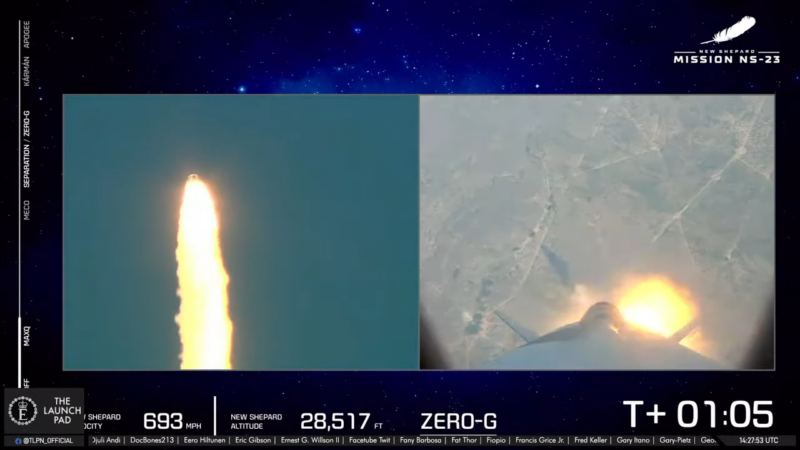On September 12, Blue Origin New Shepard mission, NS-23, failed just over one minute into an uncrewed flight, forcing the escape system to eject its New Shepard upper stage capsule, which landed safely near the launch site. Several science experiments were being carried onboard with the original flight plan calling for the capsule to reach an altitude of a little more than 60 miles, which is internationally acknowledged as the edge of space. While the flight was uncrewed and the capsule made a successful soft landing after ejecting, the scenario could have been far more ill-favored if the flight had been crewed with tourists.
“During today’s flight, the capsule escape system successfully separated the capsule from the booster,” Blue Origin announced on their Twitter page on Sept 12. “The booster impacted the ground. There are no reported injuries; all personnel have been accounted for.”
Later that day, the Federal Aviation Administration (FAA) announced New Shepard was grounded pending an investigation into the cause of the failure.
The FAA released a statement saying, “Before the New Shepard vehicle can return to flight, the FAA will determine whether any system, process, or procedure related to the mishap affected public safety. This is standard practice for all mishap investigations.”
Before this failure, Blue Origin had an astounding 22 straight successful missions, which includes three successful escape system tests. Six of these missions were crewed flights, which included celebrities such as Blue Origin Founder Jeff Bezos and aviator Wally Funk on the first crewed flight, and Star Trek star William Shatner on the second crewed flight.
On September 15, the Committee on Science, Space, and Technology with the US House of Representatives sent a letter to the FAA Acting Administrator Billy Nolen requesting that the FAA keep members of the Committee “apprised of the plans and timetable for the NS-23 anomaly investigation, the root cause of the failure once determined, and plans to ensure that actions to address the root cause or causes are completed. In addition, we request that you brief Subcommittee Majority and Minority staff within the next 10 days on the plans and process for the investigation and provide further updates on the progress of the investigation, as appropriate.” The letter was signed by Committee Chair Donald Beyer and Committee Ranking Member Brian Babin.
As always, keep doing science & keep looking up!
Featured Image: The New Shepard emergency escape system is seen ejecting the capsule away from the rocket (left), which experienced a failure (right) just over one minute into an uncrewed flight on September 12. (Credit: Blue Origin)

